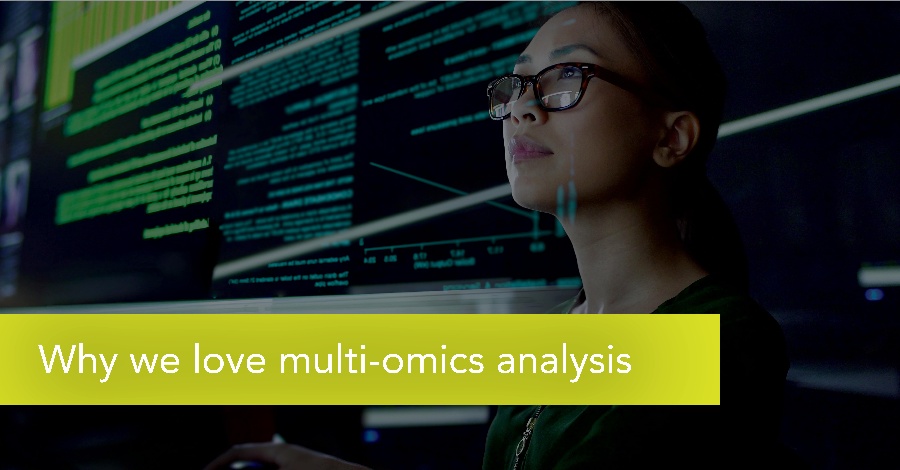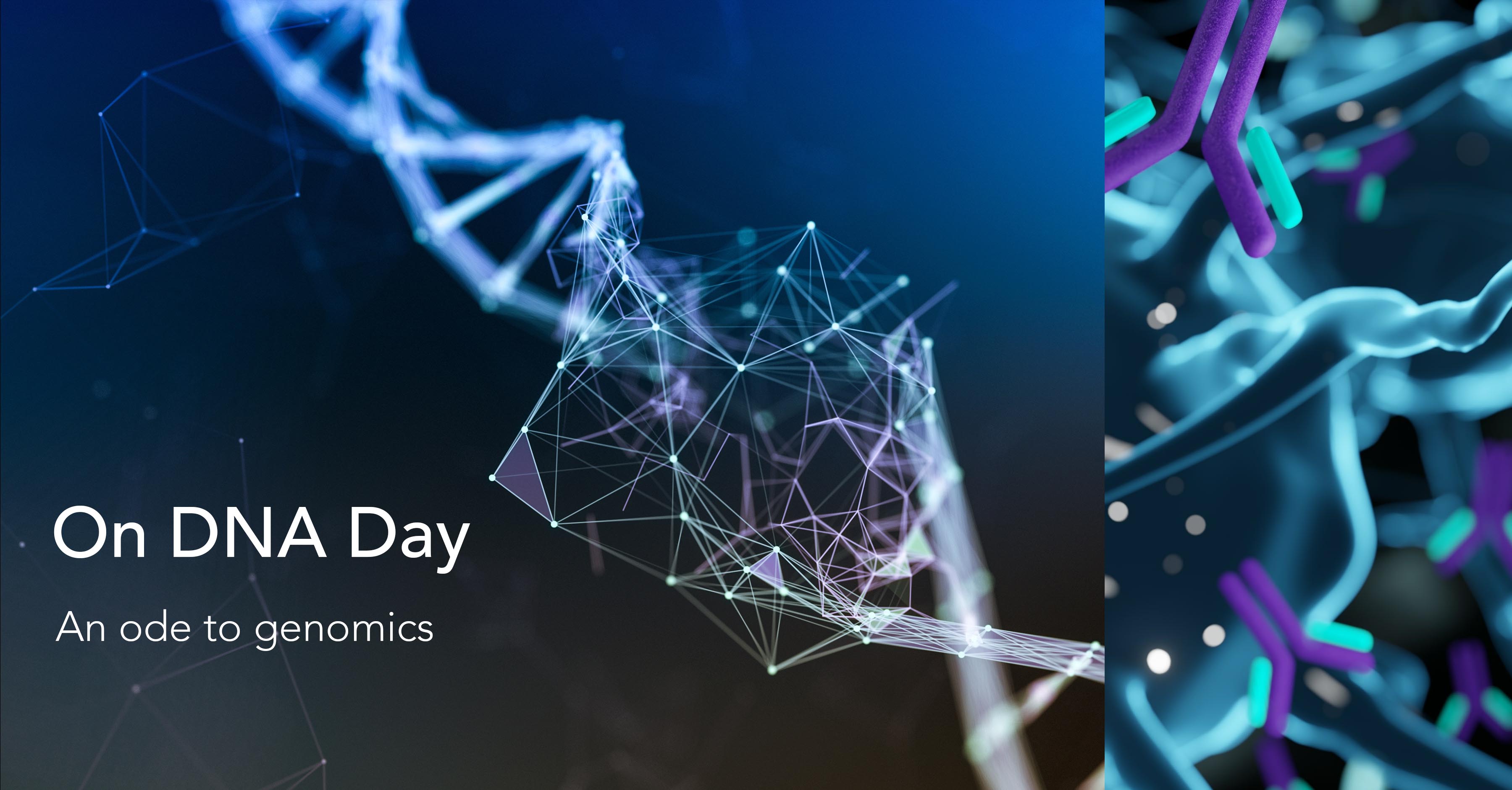Why we love multi-omics analysis

The key challenge to understanding complex biological systems is that they cannot be simply decoded as a sum of their parts. Biomedical research, therefore, is transitioning from this reductionist approach to a more holistic and integrated systems biology model to understand the bigger picture.
The first step in the transition to this holistic model is to catalog a complete parts list of biological systems and decode how they connect, interact, and individually and collectively correlate to the function and behavior of that specific system.
Omics is the science of analyzing the structure and functions of all the parts of a specific biological function, across different levels, including the gene, the protein, and metabolites.
Today, we’ll take an objective look at why we believe multi-omics is central to modern biomedical and life sciences research.
The importance of multi-omics in four points
It delivers a holistic, dynamic, high-resolution view
Omics experiments have evolved considerably since the days of single-omics data. Nowadays, it is fairly commonplace for researchers to combine multiple assays to generate multi-omics datasets.
Multi-omics is central to obtaining a detailed picture of molecular-level dynamics. The integration of multidimensional molecular datasets provides deeper insight into biological mechanisms and networks. More importantly, multi-omics can provide a dynamic view of different cell and tissue types over time which can be vital to understand the progressive effect of different environmental and genetic factors. Combining data from different modalities enables a more holistic view of biological systems and a more comprehensive understanding of the underlying dynamics.
The development of massively parallel genomic technologies is constantly broadening the scope and scale of biological modalities that can be integrated into research. At the same time, a new wave of multi-omics approaches is enabling researchers to simultaneously explore different layers of omics information to gain unparalleled insights into the internal dynamics of specific cells and tissues. Emerging technologies such as single-cell sequencing and spatial analysis are opening up new layers of biological information to deliver a comprehensive, high-resolution view at the molecular level.
It is constantly expanding & evolving
Genomics was the first omics discipline. Since then the omics sciences have been constantly expanding beyond genomics, transcriptomics, proteomics, and metabolomics which were derived from the central dogma. However, the increasing sophistication of modern high-throughput technologies means that today we have a continuously expanding variety of omics datasets focusing on multiple diverse yet complementary biological layers. In fact, the ‘omics’ suffix seems to have developed its own unique cachet that it has even crossed over into emerging scientific fields, such as polymeromics, humeomics, etc., that deal with huge volumes of data but are not related to the life sciences.
Omics technologies can be broadly classified into two categories. The first, technology-based omics, is itself further subdivided into sequencing-based omics, focusing on the genome, transcriptome, their epitomes, and interactomes, and mass spectrometry-based omics that interrogate proteome, metabolome, and interactomes not involving DNA/RNA. The second category, comprising knowledge-based omics such as immunomics and microbiomics, develops organically from the integration of multiple omics data from different computational approaches and molecular layers for specific research applications.
The consistent development of techniques to cover new omics modalities has also contributed to the trend of combining multiple techniques to simultaneously collect information from different layers. Next-generation multi-omics approaches, spearheaded by new single-cell and spatial sequencing technologies, enable researchers to concurrently explore multiple omics profiles of a sample and gain novel insights into cell systems. and mechanisms operating within specific cells and tissues, providing a greater understanding of cell biology.
It is data-driven
The omics revolution ushered in the era of big data in biological research. The exponential generation of high-throughput data following the HGP triggered the shift from traditional hypothesis-driven approaches to data-driven methodologies that opened up new perspectives and accelerated biological research and innovation.
It was not just about data volumes though. With the continuous evolution of high-throughput omics technologies came the ability to measure a wider array of biological data. The rapid development of novel omics technologies in the post-genomic era produced a wealth of multilayered biological information across transcriptomics, proteomics, epigenomics, metabolomics, spatial omics, single-cell omics, etc. The increasing availability of large-scale, multidimensional, and heterogeneous datasets created unprecedented opportunities for biological research to gain deeper and holistic insights into the inner workings of biological systems and processes. The shift from single-layer to multi-dimensional analysis also yielded better results that would have a transformative impact on a range of research areas including biomarker identification, microbiome analysis, and systems microbiology.
Researchers have already taken on the much more complex challenge of referencing the Human Multi-ome and describing normal epigenetic conditions and levels of mRNA, proteins, and metabolites in each of the 200 cell types in an adult human. When completed, this effort will deliver even more powerful datasets than those that emerged following the sequencing of the genome.
It is key to innovation
In recent years, multi-omics analysis has become a key component across several areas of biomedical and life sciences research.
Take precision medicine, for example, a practice that promotes the integration of collective and individualized clinical data with patient-specific multi-omics data to accurately diagnose health states and determine personalized therapeutic options at an individual level.
Modern AI/ML-powered bioinformatics platforms enable researchers to seamlessly integrate all relevant omics and clinical data, including unstructured textual data in order to develop predictive models that are able to identify risks much before they become clinically apparent and thereby facilitate preemptive interventions.
In the case of complex diseases, multi-omics data provide molecular profiles of disease-relevant cell types that when integrated with GWAS insights help translate genetic findings into clinical applications.
In drug discovery, multi-omics data is used to create multidimensional models that help identify and validate new drug targets, predict toxicity and develop biomarkers for downstream diagnostics in the field. Modern biomarker development relies on the effective integration of a range of omics datasets in order to obtain a more holistic understanding of diseases and to augment the accuracy and speed of identifying novel drug targets.
The future of multi-omics
Integrated multi-omics analysis has revolutionized biology and opened up new horizons for basic biology and disease research. However, the complexity of managing and integrating multi-dimensional data that drives such analyses continues to be a challenge.
Modern bioinformatics platforms are designed for multi-dimensional data. For instance, our integrated data-ingestion-to-insight platform eliminates all multi-omics data management challenges while prioritizing user experience, automation, and productivity. With unified access to all relevant data, researchers can focus on leveraging the AI-powered features of our solution to maximize the potential of multi-omics analysis.
Subscribe to our blog:






